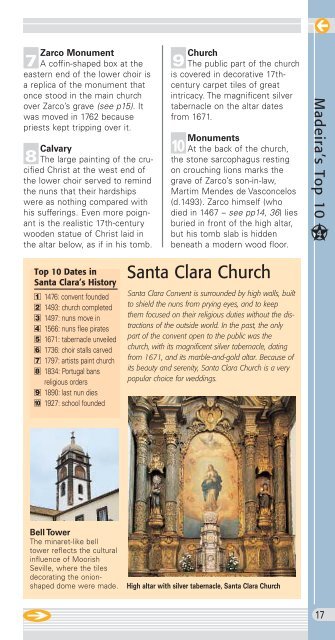Top 10 Madeira (Eyewitness Top 10 Travel Guides)
Top 10 Madeira (Eyewitness Top 10 Travel Guides)
Top 10 Madeira (Eyewitness Top 10 Travel Guides)
You also want an ePaper? Increase the reach of your titles
YUMPU automatically turns print PDFs into web optimized ePapers that Google loves.
Zarco Monument & A coffin-shaped box at the<br />
eastern end of the lower choir is<br />
a replica of the monument that<br />
once stood in the main church<br />
over Zarco’s grave (see p15). It<br />
was moved in 1762 because<br />
priests kept tripping over it.<br />
* Calvary<br />
The large painting of the crucified<br />
Christ at the west end of<br />
the lower choir served to remind<br />
the nuns that their hardships<br />
were as nothing compared with<br />
his sufferings. Even more poignant<br />
is the realistic 17th-century<br />
wooden statue of Christ laid in<br />
the altar below, as if in his tomb.<br />
<strong>Top</strong> <strong>10</strong> Dates in<br />
Santa Clara’s History<br />
1 1476: convent founded<br />
2 1493: church completed<br />
3 1497: nuns move in<br />
4 1566: nuns flee pirates<br />
5 1671: tabernacle unveiled<br />
6 1736: choir stalls carved<br />
7 1797: artists paint church<br />
8 1834: Portugal bans<br />
religious orders<br />
9 1890: last nun dies<br />
0 1927: school founded<br />
( Church<br />
The public part of the church<br />
is covered in decorative 17thcentury<br />
carpet tiles of great<br />
intricacy. The magnificent silver<br />
tabernacle on the altar dates<br />
from 1671.<br />
) Monuments<br />
At the back of the church,<br />
the stone sarcophagus resting<br />
on crouching lions marks the<br />
grave of Zarco’s son-in-law,<br />
Martim Mendes de Vasconcelos<br />
(d.1493). Zarco himself (who<br />
died in 1467 – see pp14, 36) lies<br />
buried in front of the high altar,<br />
but his tomb slab is hidden<br />
beneath a modern wood floor.<br />
Santa Clara Church<br />
Santa Clara Convent is surrounded by high walls, built<br />
to shield the nuns from prying eyes, and to keep<br />
them focused on their religious duties without the distractions<br />
of the outside world. In the past, the only<br />
part of the convent open to the public was the<br />
church, with its magnificent silver tabernacle, dating<br />
from 1671, and its marble-and-gold altar. Because of<br />
its beauty and serenity, Santa Clara Church is a very<br />
popular choice for weddings.<br />
Bell Tower<br />
The minaret-like bell<br />
tower reflects the cultural<br />
influence of Moorish<br />
Seville, where the tiles<br />
decorating the onionshaped<br />
dome were made. High altar with silver tabernacle, Santa Clara Church<br />
<strong>Madeira</strong>’s <strong>Top</strong> <strong>10</strong> 17


